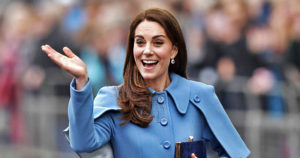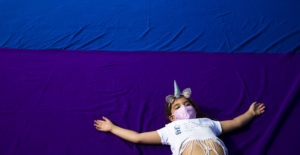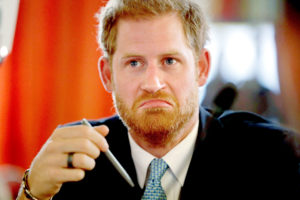It’s a strange reversal, for us to be the ones waiting for Kate. At the start of her public career, the narrative was that she was the one patiently biding her time. Nicknamed “Waity Katie” by the tabloids, she was portrayed as a middle-class climber who had got her claws into a prince and wouldn’t let go ‘til she’d dragged him up the aisle. Former school friends told the press that Kate had kept a picture of him on her wall long before she actually met him at the University of St Andrews. Other people, probably best not described as friends at all, suggested that the choice of university itself had been a ploy, pushed by her mother.
Princess-baiting is a traditional sport for the British press — think about how Sarah Ferguson was treated — but in the Noughties there was a particular savagery in the media’s attitude to famous women. This was the era of “Crazy Britney” and “Slutty Paris” and “Trainwreck Lindsay”, when no gossip could be too vicious and boundaries only seemed to exist in order to be breached. As girlfriend of the next-king-but-one, Kate was in for a rough ride.
In part because of that media environment, but perhaps more out of fear that Kate would attract a similar circus to the one around Princess Diana, her personal life was aggressively defended by the palace from very early on: in 2010, she received an estimated £10,000 payout from a photo agency over privacy invasion. In 2012, British outlets reportedly turned down topless paparazzi photos of her. A French magazine ran them, and five years later, Kate was awarded €100,000 in damages.
As a princess, she appealed to us because she was closer to being a “regular girl” than any of her predecessors. People could be as snobby as they liked about her “new money” parentage, and William’s friends allegedly were, but you could hardly say that picking spouses from the upper classes had been a storming success for the generation above. But despite her status as a commoner, as a public figure, every effort was made to keep her in the closest possible thing to fairytale seclusion.
Since Kate entered hospital for “abdominal surgery” on 14 January, those carefully guarded borders have become a liability. Only three photographs of her have emerged in as many months: two fuzzy paparazzi shots of her being driven by her mother and husband, and a portrait with her children issued for Mother’s Day. That last was intended to quiet the manic conspiracising around Kate’s three-month absence from the public eye. Instead, it turned into a week-long PR disaster after photo agencies issued a “kill notice” over obvious and inept manipulation.
In response, an already suspicious public entered a red-string fever. There was greenery in the background: did that mean the picture was actually from last year? (Look outside: it’s been a mild winter and an early spring.) Had Kate’s face been montaged in from another photo shoot? (Only if the royals have access to more advanced editing software than anyone else in the world, in which case you’d imagine they would have got the small matter of Charlotte’s cardigan sleeve correct.)
But this frenzied and dubious speculation feels less gratuitous when you remember that the royals really are concealing things. Wild theories rush into the void established in the name of “privacy”. Meanwhile in America, where UK privacy law holds no sway and the royal rota access system is irrelevant, the media freely wades into gossip and rumour that the British press can only prissily hint at. This week, for instance, Stephen Colbert gave a salacious rundown of the “Rural Rivals” situation on The Late Show. All we can do as onlookers is await information.
Kate’s predicament is specific to being a princess, but its origins lie in Noughties tabloid culture. Her brother in law, who received probably the hardest treatment of anyone in his generation of royals, dealt with it by eventually skipping the country. Kate, lacking that option, remains caught in a public image that’s been irrevocably shaped by that decade of coverage.
At least by the time she was engaged, the “Waity Katie” story had been reinvented as a triumph of feminine grit. The couple had briefly broken up before reconciling, and in a Telegraph profile of the princess-to-be, this was characterised as “Miss Middleton [making] it clear to him she would not be taken for granted”. Was it sexist? Manifestly. But royalty — an institution based on breeding and legitimacy — has the sexism baked in, despite our recent experience of living under a queen. And the longer Kate demonstrated her dignified resilience, the more truth you could say there was in the caricature.
Nonetheless, she won, and the media’s change of heart became complete: Kate was now to be protected and cherished at all costs. When Hilary Mantel wrote a critical essay about the Princess’s public image, the British press lost the run of itself entirely. The Mail called it a “venomous attack”, the Sun a “bizarre rant” (both, remember, had been pushing “Waity Katie” stories just a few years earlier). Yet if you look back at what Mantel actually wrote, it’s barely contentious at all:
“Kate seems to have been selected for her role of princess because she was irreproachable: as painfully thin as anyone could wish, without quirks, without oddities, without the risk of the emergence of character. She appears precision-made, machine-made, so different from Diana … Diana was capable of transforming herself from galumphing schoolgirl to ice queen, from wraith to Amazon. Kate seems capable of going from perfect bride to perfect mother, with no messy deviation.”
Being thin and biddable were the exact things that people liked about Kate. It was why she could later be cast in competition with Meghan: if Meghan was all LA pushiness, Kate was the epitome of home counties stoicism. It’s why, until her recent vanishing, press coverage was relentlessly fascinated with her skinny royal legs: “Very pale, very slender, both fine-boned and finely-toned,” salivated the Mail in November — at which point, given she was only a few weeks away from major surgery, it might be reasonable to assume that she was already seriously unwell.
Kate’s disappearance fascinates precisely because it is the “messy deviation” she was never supposed to commit. Depending on your class politics, she was either a sappy Cinderella, gratefully happy for her elevation; or a girl Gatsby who had scrambled her way into the gilded centre and intended to enjoy all its benefits. In neither version was she ever likely to represent an existential threat to the system she was now attached to.
Royalty, though, is a contact sport played with the whole body, and now Kate’s body has betrayed her. For all the pomp and dignity attached to the monarchy, there’s a robust physicality to the job. Traditionally, bedchambers would be the heart of royal business — a king would entertain his most powerful guests in the same place where he slept and fucked. In the Tudor court, the most esteemed role was the Groom of the Stool — that is, the courtier who helped the king to shit.
This is not an environment where “privacy” can mean quite what it does for other people, and even in our modernised monarchy, the last queen recognised that she had to be “seen to be believed”. The Waleses have attempted, ineptly, to replicate the modern way of doing celebrity — carefully issued press shots, their own curated “behind the scenes” footage designed to present a deeply stage-managed kind of “intimacy”. But what washes for Beyoncé will not wash for a princess, when the public instinctively feels a constitutional claim on the royal body; and anyway, even Beyoncé had to make an album about her husband cheating on her when the rumours started running too hot.
The clumsy photoshop of the Mother’s Day picture matters because it underlines the suspicion once articulated by Mantel: that Kate is simply too good to be true. An image of perfection substituted for a real woman, while the real woman seems to have been whittled into a cypher. Even when we could see her, she was somewhat difficult to believe in. The bargain of hereditary monarchy is that the flesh is traded for power — not symbolically, but actually, particularly for the queens and princesses whose wombs will carry the line. The longer Kate is out of view, the easier it becomes to wonder whether that’s a trade anyone should humanely be asked to make.
The barriers set up to protect her — or at least, to protect her image — were designed for the last era when the press was truly powerful. Now Kate must navigate the full force of being internet famous, caught between the physical demands of the royal body and an online version of herself that, insubstantial as it is, can be recruited to the wildest kinds of viral fictions. If Diana was the People’s Princess, the last week has made Kate into the Crowdsourced Princess — a much weirder and much less enjoyable role to play.
Disclaimer
Some of the posts we share are controversial and we do not necessarily agree with them in the whole extend. Sometimes we agree with the content or part of it but we do not agree with the narration or language. Nevertheless we find them somehow interesting, valuable and/or informative or we share them, because we strongly believe in freedom of speech, free press and journalism. We strongly encourage you to have a critical approach to all the content, do your own research and analysis to build your own opinion.
We would be glad to have your feedback.
Source: UnHerd Read the original article here: https://unherd.com/




